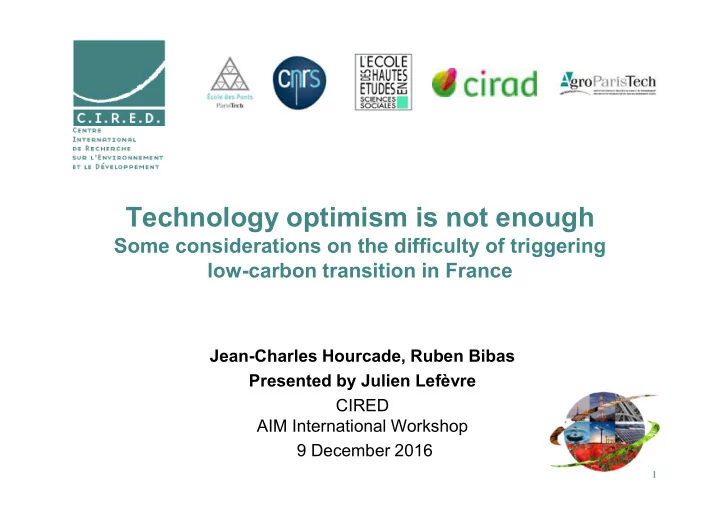

Technology optimism is not enough Some considerations on the difficulty of triggering low-carbon transition in France Jean-Charles Hourcade, Ruben Bibas Presented by Julien Lefèvre CIRED AIM International Workshop 9 December 2016 1 Photo : Mairie Paris
Question: How can one trigger transition towards factor 4 by 2050 in France? 2
Not doing anything is not an option Policies are needed! Reference -33% CO 2 emissions in 2050 relative to 1990 (analysis using IMACLIM-R France)
A set of ‘consensus’ policies & measures still insufficient for factor 4 Including: • Energy efficiency norms in new buildings • Financial incentives for energy efficiency renovation • Eco-taxes on trucks EncilowCarb PM and kerosene Reference => -61% CO 2 emissions in 2050 relative to 1990
Despite ‘engineer optimism’, a transition cost 2010- 2010- 2010- 2020- 2030- 2040- 2015 2020 2050 2030 2040 2050 REF 0.77 0.83 1.09 1.47 1.06 0.85 PM 0.73 0.9 1.15 1.32 1.46 0.9 GDP mean annual growth rate (%) 2015 2020 2030 2040 2050 PM -2 26 183 254 307 Employment variation relative to BAU (1000s full-time jobs) Computed with IMACLIM R France PM have positive macroeconomic implications in the long-run Time-lags between expenditures and benefits create short-term loss
P&M + carbon tax improve environmental performance Quinet report carbon tax: • 32€/tCO 2 in 2012 • 100€/tCO 2 in 2030 • 300€/tCO 2 in 2050 Carbon tax Revenue recycling: • ½ labor tax cuts • ½ ‘green checks’ to EncilowCarb PM households Reference => -68% CO 2 emissions in 2050 relative to 1990
But transition costs persist 2010-2015 2010-2020 2040-2050 2010-2050 REF 0.77 0.83 0.85 1.06 PM 0.73 0.90 0.90 1.15 PM + T 0.69 0.86 0.87 1.09 GDP mean annual growth rate (%) 2015 2020 2030 2040 2050 PM -2 26 183 254 307 PM + T 2 5 166 174 202 Employment variation relative to REF (1000s full-time jobs) PM+T underperforms PM • Economy-wide propagation of energy costs not compensated by lower labor taxes given recycling rule and time profile of carbon tax
P&M + carbon tax + negotiation do not improve environmental performance Share tax revenue between labor tax reduction and green checks to balance: • Competitiveness risk of Carbon tax + negotiation low reduction in labor tax EncilowCarb PM • Demand risk of low redistribution towards households Reference => -68% CO 2 emissions in 2050 relative to 1990
Now transition costs disappear 2010-2015 2010-2020 2040-2050 2010-2050 REF 0.77 0.83 0.85 1.06 PM 0.73 0.90 0.90 1.15 PM+T 0.69 0.86 0.87 1.09 PM+T+N 0.81 0.96 0.88 1.14 GDP mean annual growth rate (%) 2015 2020 2030 2040 2050 PM -2 26 183 254 307 PM+T 2 5 166 174 202 PM+T+N 36 628 Employment variation relative to REF (1000s full-time jobs) This result is not tax carbon specific.. • … But the carbon tax provides degree of freedom for social negotiation through wider tax base
Adding financial device overshoots factor 4 Financing device lowers Financial tool, signal investment risk in low- credibility carbon projects modeled as lower Carbon tax + negotiation discount rate EncilowCarb PM Increased credibility of carbon signal Reference modeled as ‘less myopic’ decisions => -85% CO 2 emissions in 2050 relative to 1990
While transition cost do not reappear 2010-2015 2010-2020 2040-2050 2010-2050 REF 0.77 0.83 0.85 1.06 PM 0.73 0.90 0.90 1.15 PM+T 0.69 0.86 0.87 1.09 PM+T+N 0.81 0.96 0.88 1.14 GDP mean annual growth rate (%) PM+T+N+F 0.77 0.9 0.94 1.2 GDP mean annual growth rate (%) Complementarity between financial device and carbon tax: • Lower carbon tax (50€/tCO 2 instead of 300€ in 2050) yields Factor 4 and improves growth However, this result assumes political, social and technical capacity to enforce a diverse set of measures
Conclusion Question: How can one trigger transition towards factor 4 by 2050 in France? A heuristic tale suggests that … … technology is not enough and deep decarbonisation is possible only if embedded in a broader social contract , including: sectoral policies carbon fiscal reform labor markets and labor regulations financial intermediation
Thank you www.centre-cired.fr 13 Photo : Mairie Paris
References Bibas, Ruben, Jean-Charles Hourcade. 2013. Transitions énergétiques en France : enseignements d’exercices de prospective. Contribution au débat national sur la transition énergétique. CIRED working paper n°51. http://www.centre-cired.fr/spip.php?article1564 Encilowcarb Project: http://www.centre- cired.fr/spip.php?article996&lang=en Mathy, Sandrine, Meike Fink, and Ruben Bibas. 2014 “Rethinking the Role of Scenarios : Participatory Scripting of Low-Carbon Scenarios for France.” Energy Policy 77:176–90. http://dx.doi.org/10.1016/j.enpol.2014.11.002 http://www.imaclim.centre-cired.fr/IMG/pdf/20120117- CIRED-BibasMathyHourcade- commissionEnergie2050.pdf 14
Appendix: Finance is needed in an uncertain world
Recommend
More recommend